Architects are undoubtedly masters of design, especially when it comes to physical spaces. However, when it comes to website development, the design principles can be quite different. In digital design, visual elements are key—not only in terms of how they look but also in how site visitors interact with them. User experience, also called UX, is a critical component of effective website design.
At Loggia, we’ve audited hundreds of architect websites and found that many contain the following UX issues:
I. Not Responsive
Mobile devices account for nearly 60% of global website traffic; simply put, a lot of your website visitors are checking out your firm on their smartphones. It’s critical that all screen sizes be considered when developing your site. Slideshows featuring project photos are common on architect sites but they can be highly problematic; when not built to be responsive, slideshows can be difficult to maneuver on small screens. This can frustrate users and lead to a higher bounce rate. It’s essential to ensure that images are optimized for mobile devices and that navigation remains user-friendly across all platforms.
II. Using Splash or Entrance Pages
Splash pages or entrance pages might seem like a good idea to make a strong first impression, but they often do more harm than good. These pages can slow down access to the main content and are usually skipped by users who want immediate information. Instead, focus on creating a homepage that immediately communicates your value proposition and directs visitors to the most important sections of your site.
III. Lack of Accessibility
Many architect websites are not built in accordance with the Web Content Accessibility Guidelines (WCAG). This means they might not be accessible to all users, including those with disabilities. Ensuring your website meets these guidelines is not only a legal requirement in many places but also expands your audience by making your site usable by everyone. This includes features like text-to-speech compatibility, keyboard navigation, and sufficient color contrast.
By addressing these common UX mistakes, architects can significantly improve the effectiveness of their websites. At Loggia, we specialize in helping architects create websites that are not only visually stunning but also highly functional and user-friendly. Remember, a well-designed website is a powerful tool that can help you attract and retain clients. If you need assistance with your website’s UX, don’t hesitate to reach out to us. Let’s make your digital space as impressive as your physical designs.
